Tramping New Zealand: The South Island’s Best Hikes
Don’t miss these incredible multi-day tramps and day hikes on New Zealand’s South Island: iconic Great Walks such as the Milford Track, challenging trails in Mount Cook and Paparoa National Parks, and moderate strolls along Hokitika Gorge and near Fox Glacier.
 Photo © Alicia Erickson
Photo © Alicia Erickson
New Zealand’s South Island is a wilderness lover’s dream – lush rainforest, wild beaches, glacial peaks, alpine terrain, vivid blue lakes, and fields blooming with periwinkle and golden lupins. A resounding “wow” was the motto of our trip as we headed from Christchurch to the West Coast and drove through Arthur’s Pass. Around each corner was scenery more impressive than before.
The only plan each day was to drive and hike, drive and hike. The best, or arguably, the only way to truly experience the natural abundance of New Zealand is to head into the backcountry and explore the landscape on foot.
The South Island’s diversity of landscapes is unprecedented and the lack of predatory plants and animals – unlike its closest neighbor, Australia – is the perfect formula for stress-free adventures with high rewards among New Zealand’s wildest reaches. As a cherry on top, the country’s outdoors scene is well organized with marked routes and huts, making both day and multi-day hiking trips accessible and fairly easy to plan.
- The classics: Milford, Routeburn, and Kepler
- Multi-day alternatives to the iconic tracks
- Day hikes on the South Island
- Preparing for hut-to-hut tramping
- When to go
Multi-day treks
The classics: Milford, Routeburn, and Kepler
If you’re heading out overnight on foot in New Zealand, you’re not hiking, you’re tramping. These three tramps, all located in Fiordland and Mt Aspiring National Parks, are three of New Zealand’s “Great Walks”. They’re well-maintained tracks through sensational scenery, with waitlists and price tags to match. The tramping season runs from October to April, and to walk any of these tracks, you’ll need to book bunks in the huts, or campsites. They’re not cheap (NZD $68-110 per night for huts, NZD $21-32 for campsites), but well worth the money if you’ve got the budget to do it.
Extra costs include transport (buses are your most affordable option). Te Anau is your best base for the Milford and Kepler tracks, Queenstown is an option if you’re doing the Routeburn.
The Routeburn (20mi/32km, intermediate, 3 days): The Routeburn traverses from the upper end of Lake Wakatipu (near Queenstown) to The Divide, halfway along the road from Te Anau to Milford Sound. It offers big mountain scenery, cascading waterfalls, and perfect alpine plunge pools.
The Milford Track (33.5mi/54km, intermediate, 4 days): The Milford Track runs from the top end of Lake Te Anau to the back entrance into Milford Sound. You start on a boat. You end on a boat. For isolation, the Milford Track is unrivaled among New Zealand’s popular tramps – this is helped by the fact that only 40 people can start the track per day.
The track climbs over MacKinnon Pass (don’t miss Sutherland Falls, New Zealand’s tallest waterfall, or New Zealand’s most scenic toilet) and into the Arthur Valley. Bonus points if it’s raining on your last day on the track: hundreds of waterfalls cascade down the sides of the valley, and emerging into Milford Sound in the mist is spectacular.
The Kepler Track (37mi/60km, intermediate, 3-4 days): The Kepler, at the south end of Lake Te Anau, is the area’s slightly lesser-known cousin, but still a “Great Walk”. After a steep day-one climb to Luxmore Hut, you’ll traverse a mountainous backbone between sharp peaks, before walking out alongside waterfalls and winding rivers.
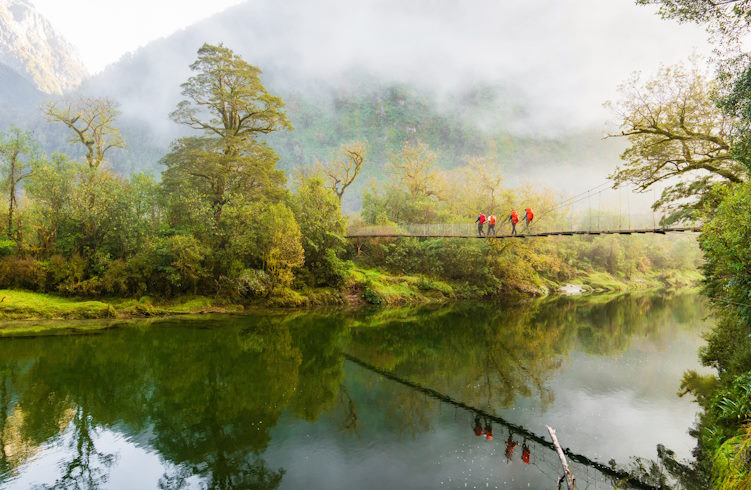
Multi-day alternatives to the iconic tracks
Paparoa Track (34mi/55km, challenging, 3-4 days): Considered to be the 10th “Great Walk” of New Zealand, Paparoa Track will bring you on a multi-day journey through the vivid and varied landscapes of Punakaiki, on the South Island’s wild west coast. The trek starts off in the depths of tropical rainforest, where we walked through alpine scrub and among limestone gorges along the Pororari River. Expect to be climbing for much of the way. The route definitely requires a decent level of physical fitness.
You have the option to spend two or three nights on the track. Pororari Hut and Moonlight Tops Hut will be your first two stops. Add Ces Clark Hut if you’re up for a third night. The park is free but each of the huts cost NZD $45-55/night for adults in shoulder season (free for 17 and under), advance booking required. Make sure to bring plenty of warm layers and raingear as storms can come through the park.
West Coast Wilderness Trail (22mi/35km, point-to-point, moderate, 1-2 days): If you’re after an extended trek through the Hokitika area, hop on the West Coast Wilderness Trail. Start from Cowboy Paradise, wander through open meadows of native bush, and catch views over the valley from Arahura River. Continue along Kaniere Road to reach the sky-blue waters of Hokitika River. Mudflats Hut and Grassy Flat Hut offer simple bunk accommodation if you want to break up your trek. Otherwise, start early and you should be able to conquer it in one day.
Day hikes on the South Island
Aoraki/Mount Cook
Mount Cook National Park, or rather, Aoraki in Maori, is home to an immense swath of mountains, glaciers, and lakes with the highest peaks in New Zealand. There is little lodging available in the vicinity of this renowned national park, save for one lodge and a few campgrounds. You may consider setting up base in the nearby town of Lake Tekapo and coming into the park for day hikes. What it lacks in accommodation, Aoraki makes up for in incredible beauty and an abundance of day hikes with a range of difficulty.
Hooker Valley (6.5mi/10.5km, moderate): Hooker Valley came highly recommended by almost everyone we met and within seconds of setting out on the path, it was easy to see why. Hooker Valley is a spectacularly scenic (and subsequently popular) half-day hike. I followed a path that switched between a well-maintained trail and a wooden boardwalk. The slope up and down through the alpine terrain was gentle, which made for an enjoyable stroll while soaking up the scenery. Yellow brush spread out all around us before the landscape swept up into snowy slopes and dramatic, rocky crags. It was a perfect backdrop for a picnic, which we enjoyed from one of the picnic tables along the way.
Sealey Tarns/Mueller Hut (6mi/10km, moderate-challenging): On our second day at Mount Cook, we returned to conquer Mueller Hut. One of the more demanding day hikes in Aoraki National Park, Mueller Hut is an all-day excursion that gets you up into the mountains. Don’t be deceived by the fairly short distance – the hike is much more grueling than it lets on. A mix of mental and physical endurance helped me up the seemingly never-ending steps.
After the ascent, we relished the views at Sealey Turns, the halfway point. The incredibly scenic picnic table is ideal for a break, though it was a bit brisk and windy. You can choose to turn around here or trudge on up a steep slope to Mueller Hut. The views of glaciers and rock faces – as well as the hike itself – just might take your breath away. While a popular day hike, it is also possible to stay overnight at Mueller Hut. Overnight bookings for the hut are mandatory from mid-November through April.
Paparoa National Park (Punakaiki)
Paparoa National Park is a far cry from the Aoraki’s alpine terrain. In Punakaiki, I couldn’t shake the resemblance to Jurassic Park. Towering limestone formations rise above crashing waves and trails weave through temperate rainforest dense with Nikau palms and green foliage. The area is also known for its “pancake rocks” – stacks of limestone resembling towering stacks of pancakes along the beach that are fun to climb around.
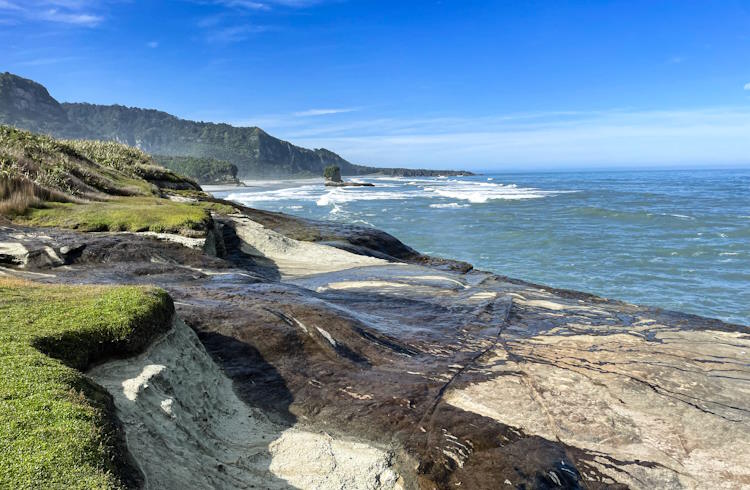
Pororari River Track (4mi/6.5km, moderately easy): This moderate day hike follows a fairly level trail along the river and is the entrance/exit for the Paparoa Great Walk. Parking is accessible near the trail at Pororari River bridge. As we walked along the rushing river, immersed in coastal rainforest and surrounded by limestone structures, I looked up in awe, feeling as if I were in a fairytale forest from another time. The path is mostly flat and perfect for an afternoon walk.
Hokitika River
Located on the West Cost of the South Island, Hokitika River stretches for 40 miles from the Southern Alps to the Tasman Sea. The icy blue waters are worthy of a peek at the very least and are accessible through a few short tails.
Hokitika Gorge Walk (1.3mi/2km, easy): This short loop is accessible for most levels of ability and packed with incredible scenery throughout. While not one of our more challenging hikes, Hokitika Gorge was an ideal stop on the drive and the scenery was spellbinding from the very beginning. We walked through thick forest and across bridges and peered down into the mesmerizing blue waters below. The path leads down to a rocky beach near the river where you can relax and take in the peace of the forest and the sounds of the rushing water.
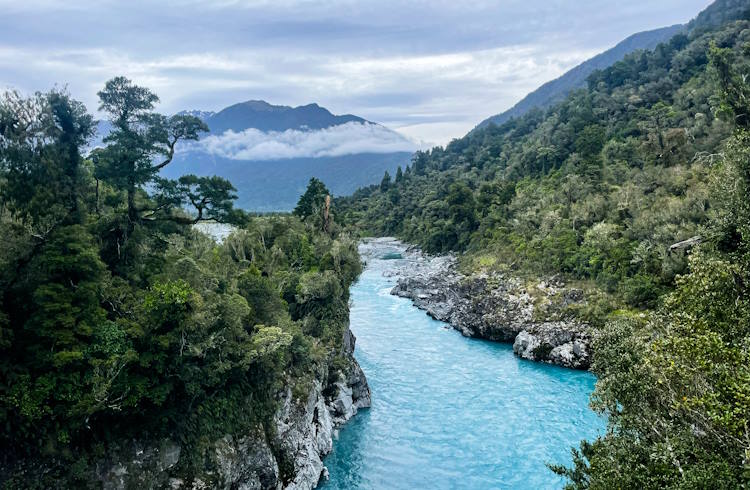
Westland Tai Poutini National Park/Fox Glacier
Situated on the foothills of the Southern Alps, the tiny township of Fox Glacier is a popular hub for hiking and glacier exploring in Westland Tai Poutini National Park. While it’s possible to go on a helicopter ride to the top or a guided glacier hike requiring ice axes and other snow gear, numerous trails also wind through the vicinity of the park.
Robert’s Point Track (6.8mi/11km, moderate): While there are many short tracks in the Fox Glacier area, Robert’s Point adds a bit more to your glacier-seeking adventures. Rather underwhelmed by some of the shorter and more heavily trafficked trails in Fox Glacier, we were thrilled by both the accessibility and challenge presented by Robert’s Point. The track mixes ascents and descents, including some very steep trail and several bridge crossings. Sturdy hiking boots are important as the path can be quite slippery. All woes are forgotten once up top taking in the views of the mammoth glaciers.
Lake Tekapo
Lake Tekapo is a charming township situated on the picturesque lake of the same name, abundant in lupin fields. Like most of the South Island, hiking paths are abundant. If you wind up spending a night, the area is also a renowned Night Sky Reserve.
Mount John Via Lake Shore Walk (5.1mi/8.2km, moderate): If you’re interested in venturing beyond the town limits where views are plentiful, Mount John is a fantastic and very moderate half-day excursion. The initial ascent past the springs is steep. The path eventually levels out and follows along the milky turquoise waters of Lake Tekapo. Look out for grazing sheep and views over Mount John on clear days. The trail is quite exposed so remember to pack sunscreen, regardless of the weather!
Preparing for hut-to-hut tramping
New Zealand has an amazing network of tramping huts, all maintained by the Department of Conservation (DOC). Some huts need to be pre-booked, while others don’t take advanced booking. If possible, do some planning ahead of time and book what you can to ensure your tramping experience goes as smoothly as possible.
When to go
Hiking season in the South Island runs October to April. November was a fantastic time to experience the tramping scene. Traveling during late spring meant summer crowds hadn’t quite reached the South Island, trails were relatively quiet, and there was still some availability for last minute bookings. Days were mostly sunny and warm-ish, while evenings were cool – ideal hiking conditions. Late sunsets maximized our days, which were often spent hiking until around 9pm.
Additional reporting by Helen Glenny.
Related articles
Simple and flexible travel insurance
You can buy at home or while traveling, and claim online from anywhere in the world. With 150+ adventure activities covered and 24/7 emergency assistance.
Get a quote
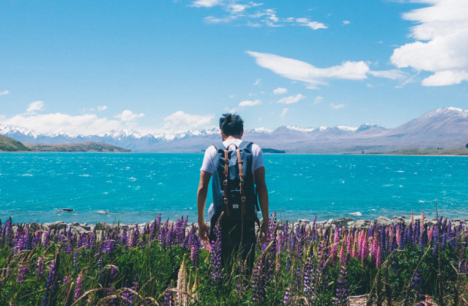
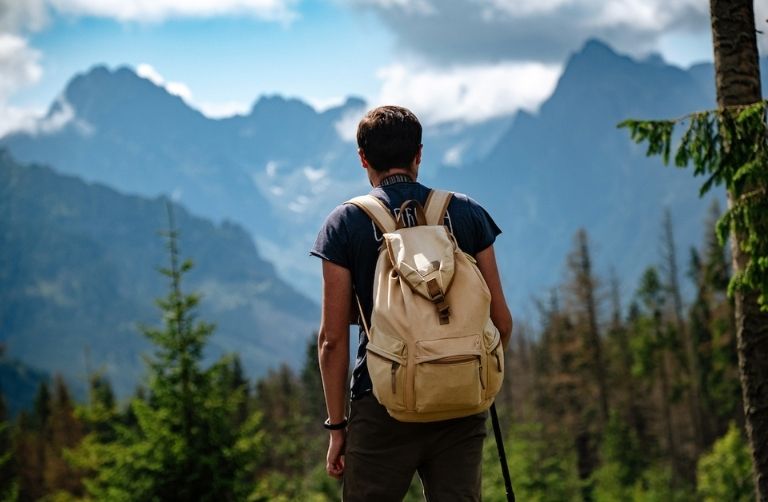
No Comments